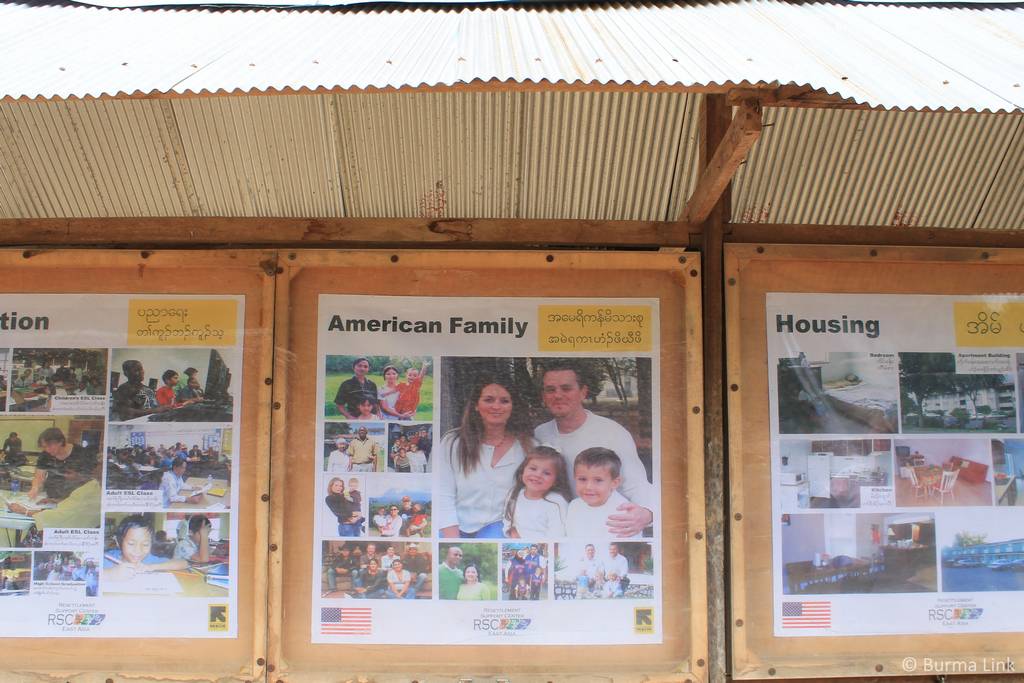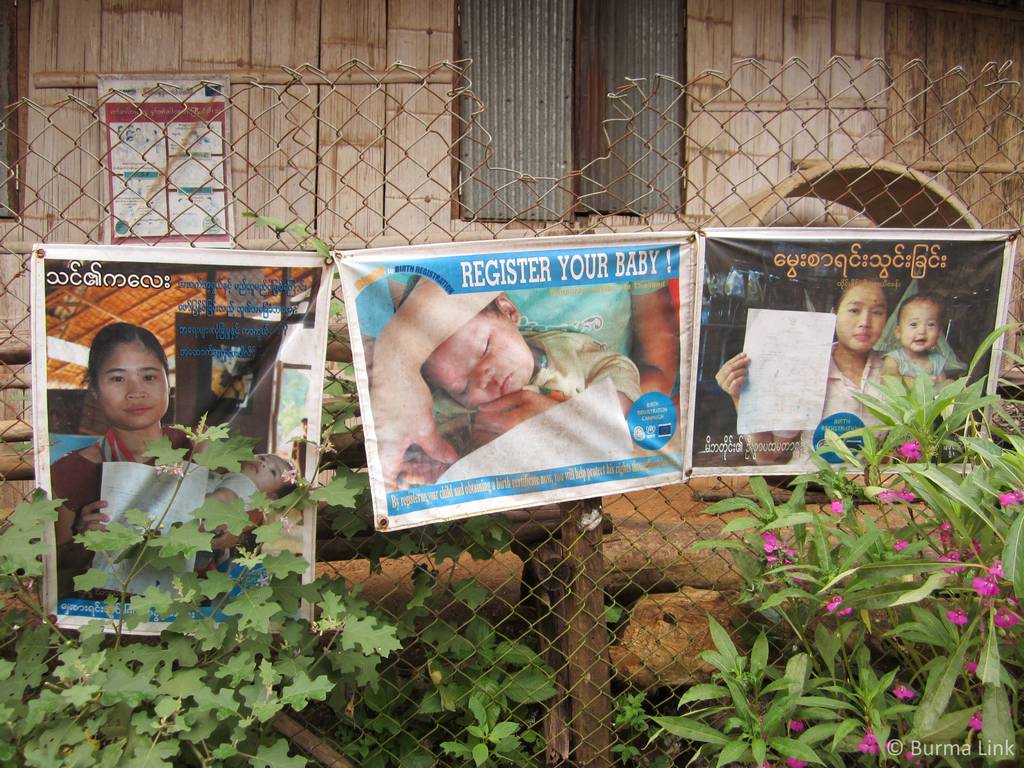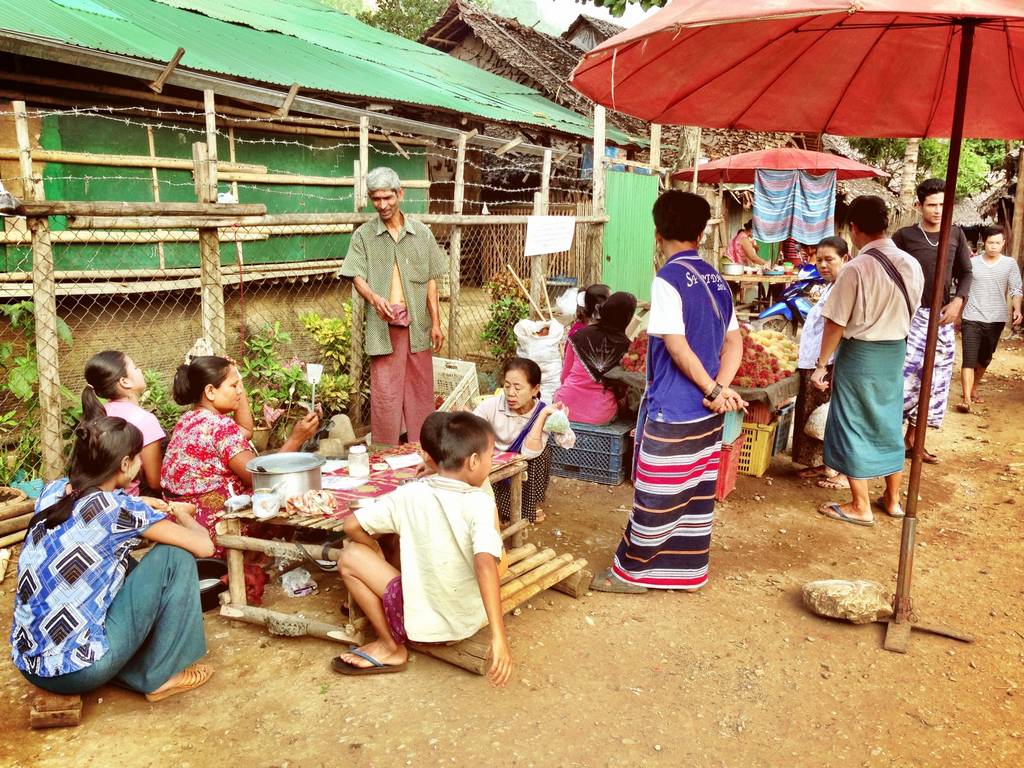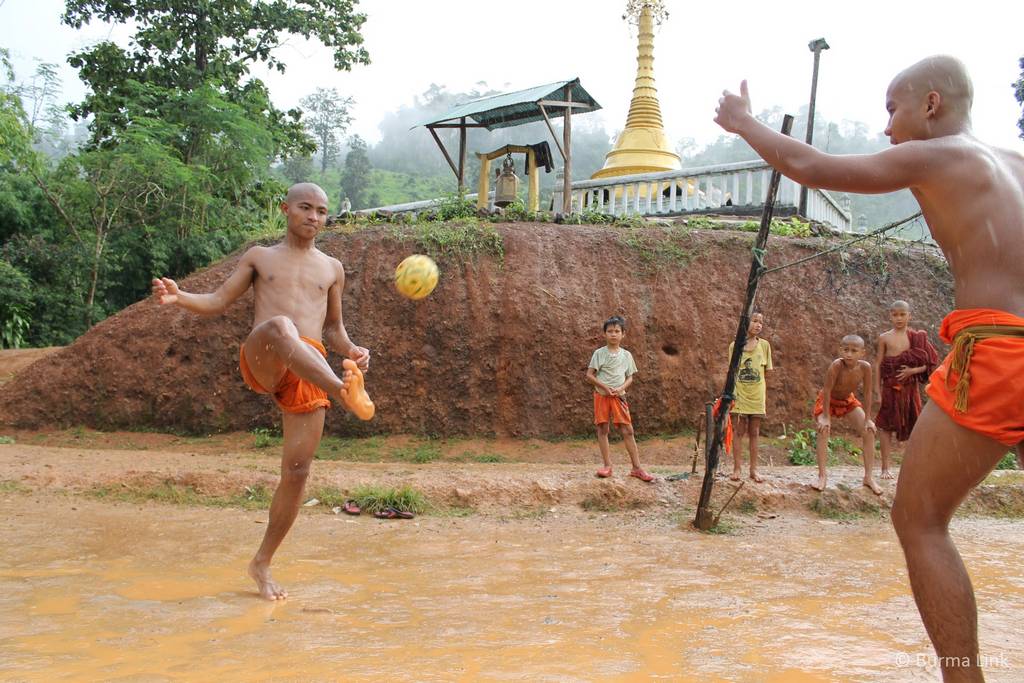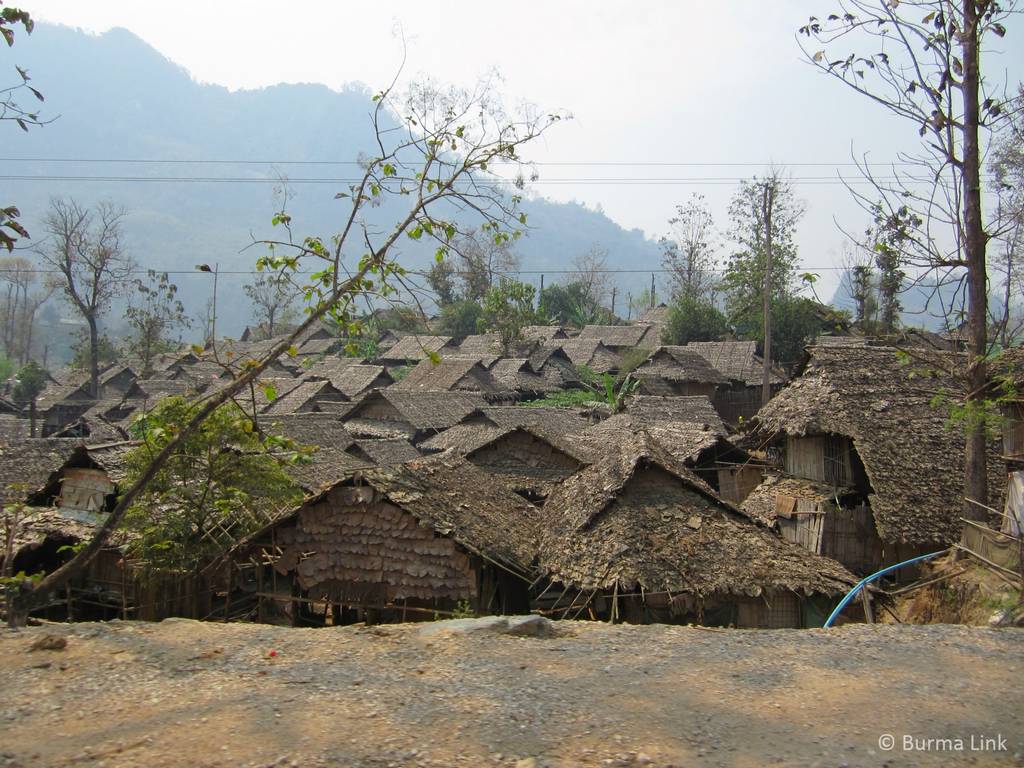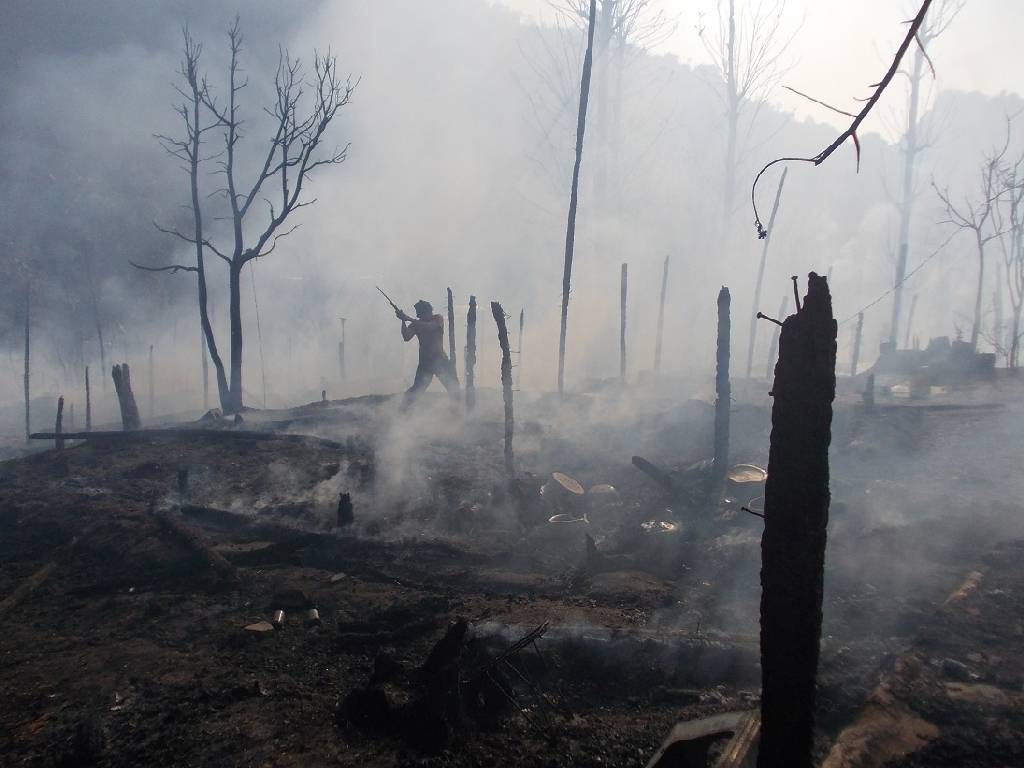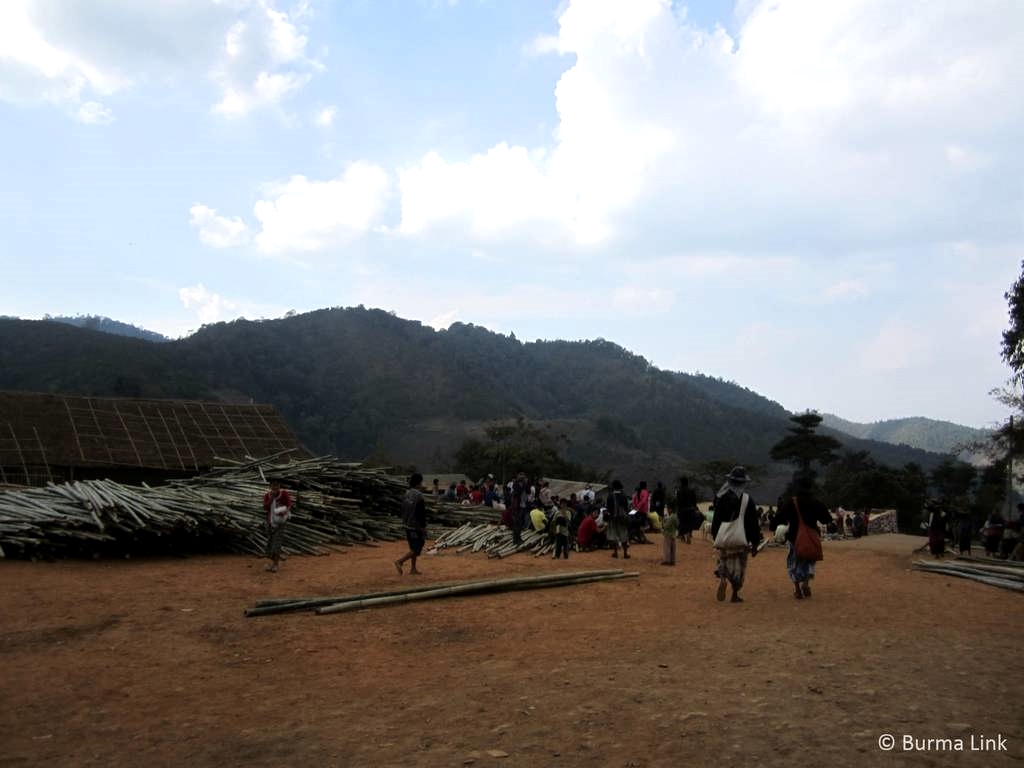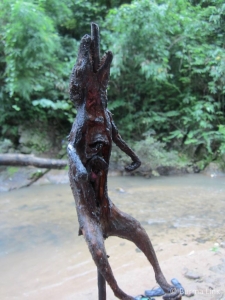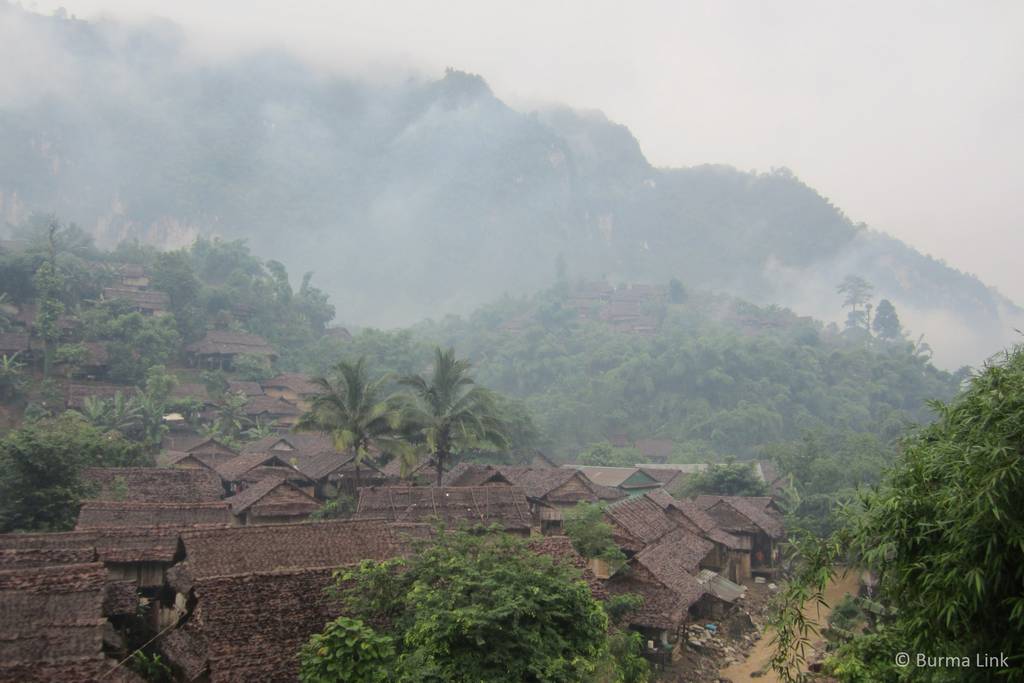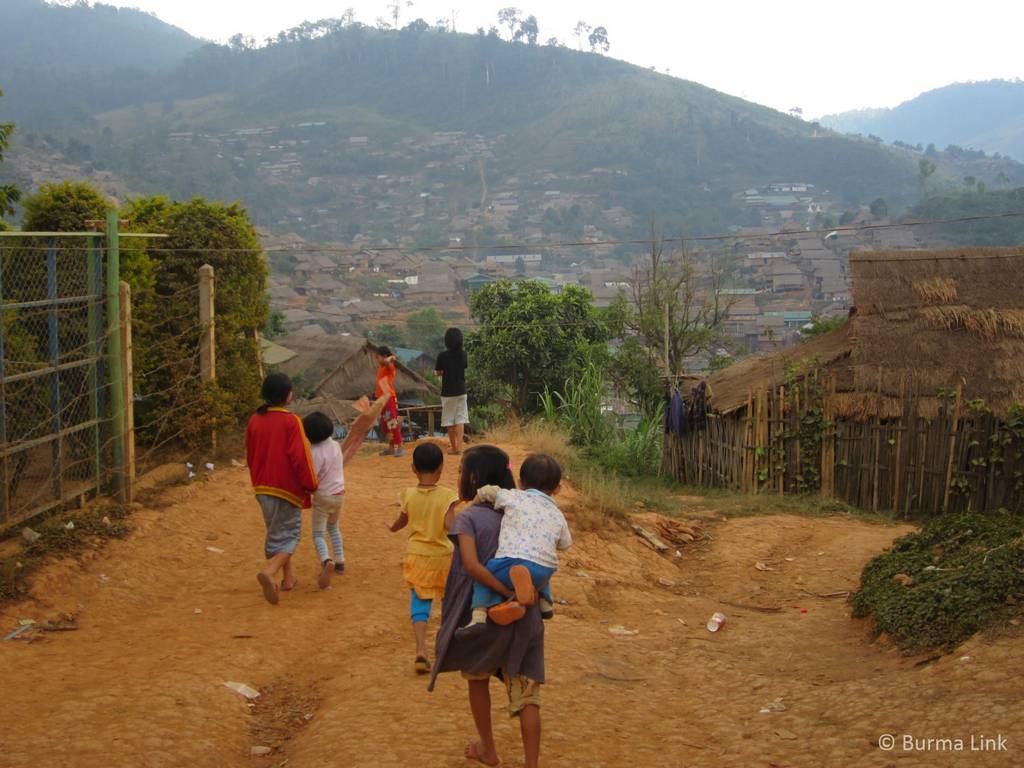“It is so strict to live here. There is nothing to do. I am not allowed to go outside the camp. There is no job, no work. So much stress and depression. I feel that I am going to go crazy here.” (Burmese refugee, Nu Po camp, Tak province, January 2012; Human Rights Watch, 2012e, p. 18)
Meanwhile, many older people have lived in the camps for so long that they can hardly remember their homeland anymore. This is all the while the refugee camps are only considered “temporary shelters” by Thai authorities who can close down the camps whenever they decide to do so. Thailand, in recent years, has made it no secret that they want to close the camps, causing growing concerns among the refugee population who do not feel safe to return.
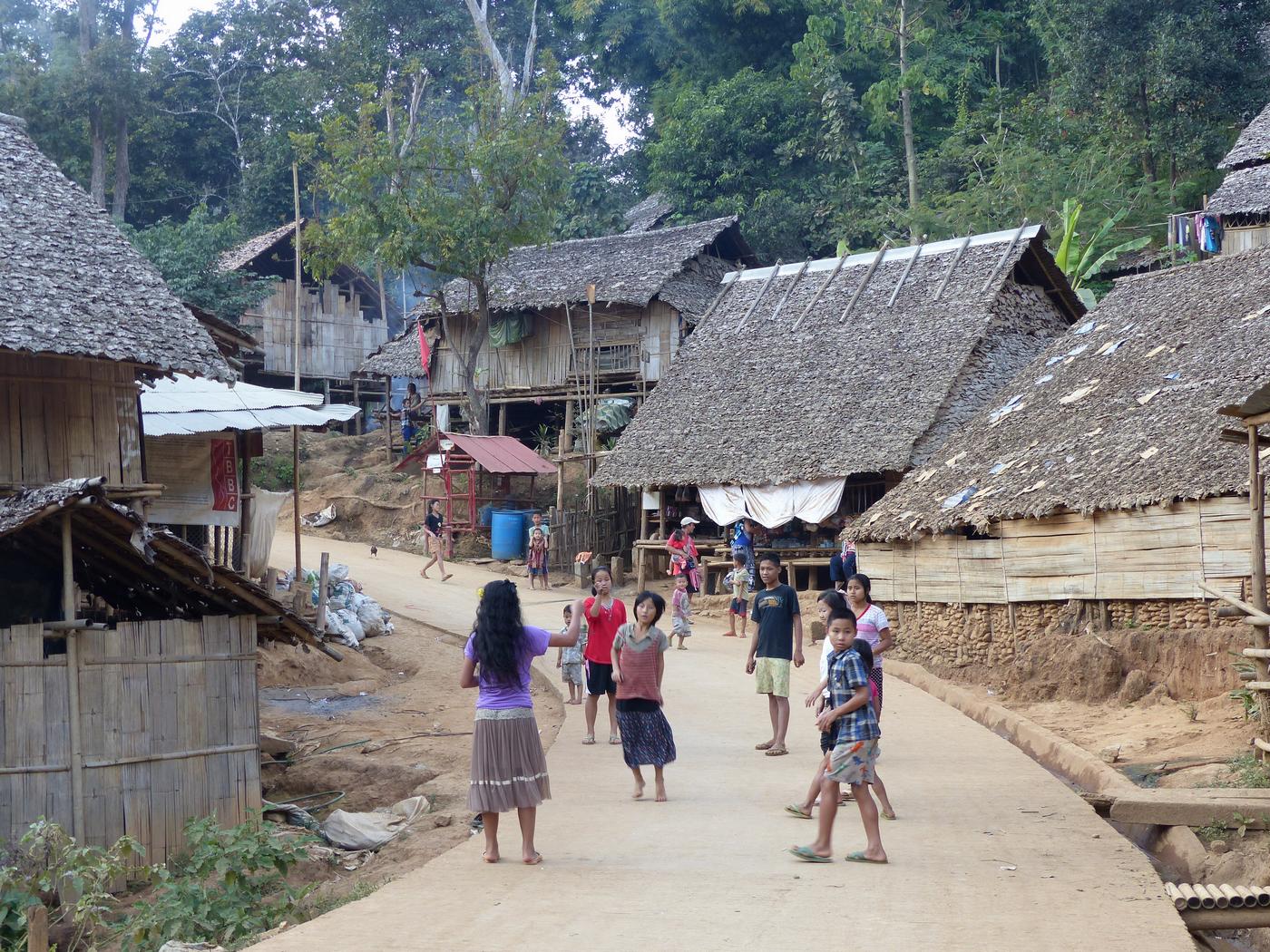
Children playing in Mae La Oon refugee camp, three hour drive from across the mountains from the town of Mae Sariang, Thailand. (Photo: Burma Link)
When the first refugees arrived in 1984, no one could have ever predicted that only would they still be there 30 years on. Majority of the refugees in the camps are Karen (79.1%) or Karenni (10.3%) from eastern Burma (TBC, December, 2014), who have fled armed conflicts and/or horrendous human rights abuse and persecution by the Burmese military. The government policy of Four Cuts, and what has been described as the slow genocide of ethnic peoples (La Guardia, June, 2005), resulted in the widespread destruction of communities and the decline of traditional cultures. Thousands of villages, especially in the Karen and Karenni States, were burned to the ground, including houses, religious buildings, schools, belongings, and sometimes even domestic animals. In many areas, it became the norm for the villagers to live in a constant fear of the Burmese military coming to their village, terrorising the villagers, stealing their food, forcing villagers to become porters and mine sweepers, raping ethnic women, and torturing and killing anyone suspected of having a connection the ethnic armed opposition. Whilst some villagers endured the abuse by developing warning systems and repeatedly fleeing to the jungle, others, who had heard about Thailand, decided to leave their village for good. Others still had no choice as their village was already in ashes on the ground.
Until 1995, refugees on the Thailand-Burma border lived in village-type settlements and were allowed to travel outside the camps to get food and shelter materials. Camp life changed dramatically in 1995 after the DKBA attacks; the village-type settlements were merged into large, sprawling camps that became increasingly dependent on outside aid as residents became more and more restricted on space and movement (TBC, 2004). Refugees still frequently break the rules of confinement and as a consequence, are often detained and occasionally deported (e.g. SHRF & SWAN, 2002). There are even reports of refugees been found killed outside the camp fences under mysterious circumstances (see e.g. Human Rights Watch, 2012e, pp. 37-38; Poe Kwa Lay, November 2012). Refugees have no means of seeking redress; similarly to Burmese authorities in their home country, Thai officials often seem to enjoy total impunity (see Human Rights Watch, 2012e).
Throughout the 1980s, 1990s, and 2000s, more refugees kept pouring across the border to Thailand. Alongside the growing need, a humanitarian and human rights network grew along the border. One of the organisations to respond to the crisis is The Border Consortium (TBC), which remains the main agency organising food and other aid to the refugees. TBC was originally formed by TBC’s former Executive Director Jack Dundorf who was among the first people to witness and respond to the urgent needs of thousands of refugees who fled to Thailand in 1984. TBC gradually evolved into a multi-membership aid organisation, and is one of the Executive Members of the Committee for Coordination of Services to Displaced Persons in Thailand (CCSDPT) that works together with the UNHCR to coordinate all humanitarian service and protection activities in Thailand.
TBC maintains a database which includes all registered and unregistered refugees and is shared with the UNHCR to ensure compatibility. The database is updated monthly for births, deaths, departures, and new arrivals, to create the ‘verified caseload’. Food rations are distributed only to those who show up in person to receive their supplies. The actual number of people fed each month is known as the “feeding figure.” According to the December 2014 figures, the verified caseload in the camps was 110,607 and the feeding figure 108,583. As nearly 100,000 have been resettled to third countries, current numbers do not represent the overall population that has fled to the camps over the years.
In the camps, refugees have limited educational and training opportunities and no official means of earning an income. While education in the camps is far better than any education available to civilians inside Burma, there are limited opportunities for higher education, which also largely remains unrecognised outside the camps. Karen and other ethnic peoples of Burma traditionally place a very high value on education and many have crossed the border to Thailand in order to go to a camp school. Although the majority of the camp populations have arrived as a family unit (TBC, 2012b), many parents also send their children to attend schools in refugee camps across the Thai border (KHRG, 2008).
“If we had stayed in the village, we knew that our children could never attend school and I wanted my children to go to school to be educated people. We also didn’t have any house to stay in. We could only stay in the forest and we had to flee away when the SPDC came or patrolled around our area, so we decided it was better to go to the refugee camp.” (Saw P—, a 47-year-old male from P— village, Papun District; KHRG, 2008, p. 58)
With more than 40,000 residents, Mae La is the biggest of the refugee camps on the Thailand-Burma border. Due to its size and easily accessibly location, Mae La is considered a centre of study for refugees. Mae La’s current population includes 1,039 boarding house students who have come to study in the camp mostly from Burma. In total, as of July 2014 there were 2,763 boarding house students in the camps (TBC, 2014a). Many other students also stay with their relatives in the camps. The issue for many young students is what happens after they finish a post-ten school, the highest level of education available in most of the camps. There are only a handful of schools on the Thailand-Burma border where these young students can apply for, leaving thousands of talented and dedicated aspiring university students with no means to educate themselves.
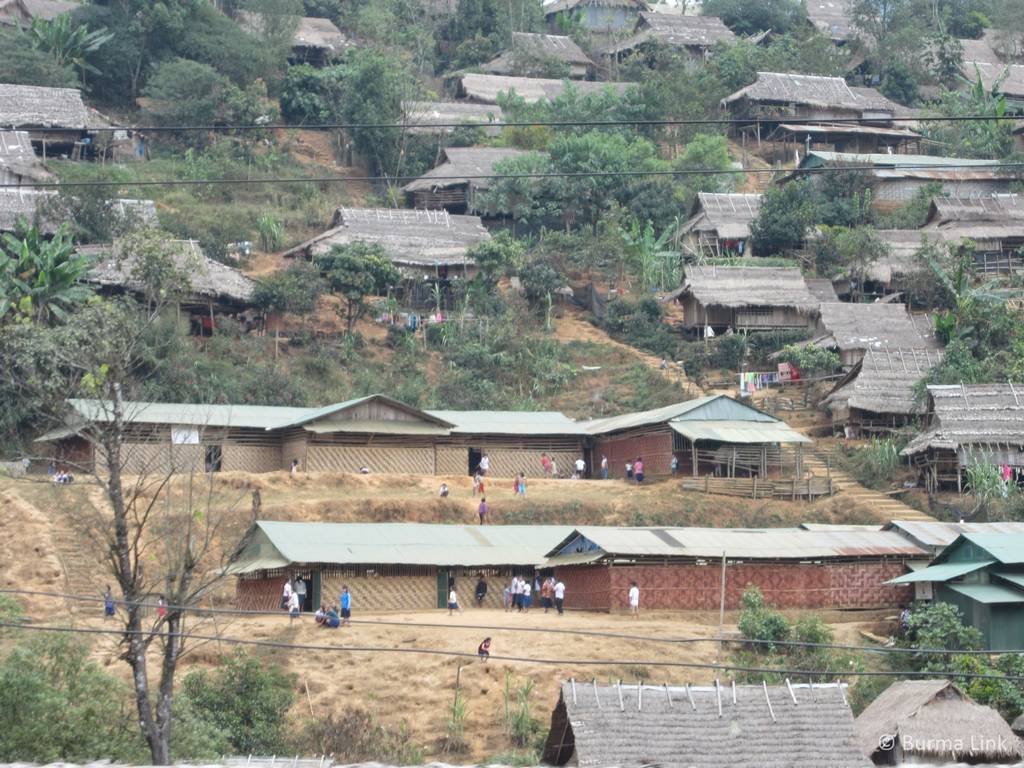
School in Umpiem Mai refugee camp. Many people of Burma cross the border to Thailand for their children to get the opportunity to attend schools. (Photo: Burma Link)
Education in the camps is provided by CBOs such as the Karen Refugee Committee – Education Entity (KRC-EE) backed up by international NGOs such as World Education. Many schools, especially in the less remote camps in Tak Province, have foreign teachers and volunteers, majority of whom stay illegally in the camps as permits remain largely unattainable. These foreigners teach refugees English and other subjects while hiding from Thai authorities, risking fines or even deportation. After the Thai junta took over power in May 2014, however, it has become increasingly difficult to enter and stay in the camps without a permit.
Educational opportunities also vary greatly from one camp to the next. In the more remote camps such as Mae La Oon in Mae Hong Son Province and Ban Don Yang in Kanchanaburi Province, situation is dire as education remains largely unattainable, and higher education institutions are far away out of reach. Most of these opportunities are available either in the Tak camps – Mae La, Umpiem Mai and Nu Po – or in the border town of Mae Sot.
One of the most prestigious of the schools available for refugees is the Australian Catholic University (ACU), which offers a Diploma in Liberal Studies in Mae Sot as well as in Ranong. Other commendable schools include the Wide Horizons and Minmahaw GED Programs in Mae Sot, English Immersion Program in Umpiem Mai, and Global Border Studies Program in Nu Po. As these opportunities are only available to a few students each year, thousands of capable young adults are left with no means to pursue their dream of higher education. Many young people are determined to help their people and their country, but with no place to go for study, they often end up opening a shop or becoming a nurse or a teacher in the camp. Some leave to find factory work in Bangkok or elsewhere in Thailand while many others turn to drugs and alcohol, or even commit suicide, as they see their dreams crushed before them.
Having lived in a place where freedom of movement as well as self-expression is severely restricted, many young refugees feel scared about leaving the refugee camps even to pursue higher education in other camps on the border. Most have heard stories about the police check points and intimidation by Thai authorities that sometimes takes place even when refugees have managed to obtain travel documents (Human Rights Watch, 2012e). Others have already experienced being thrown to a detention centre and are reluctant to take the risk of leaving the camps.
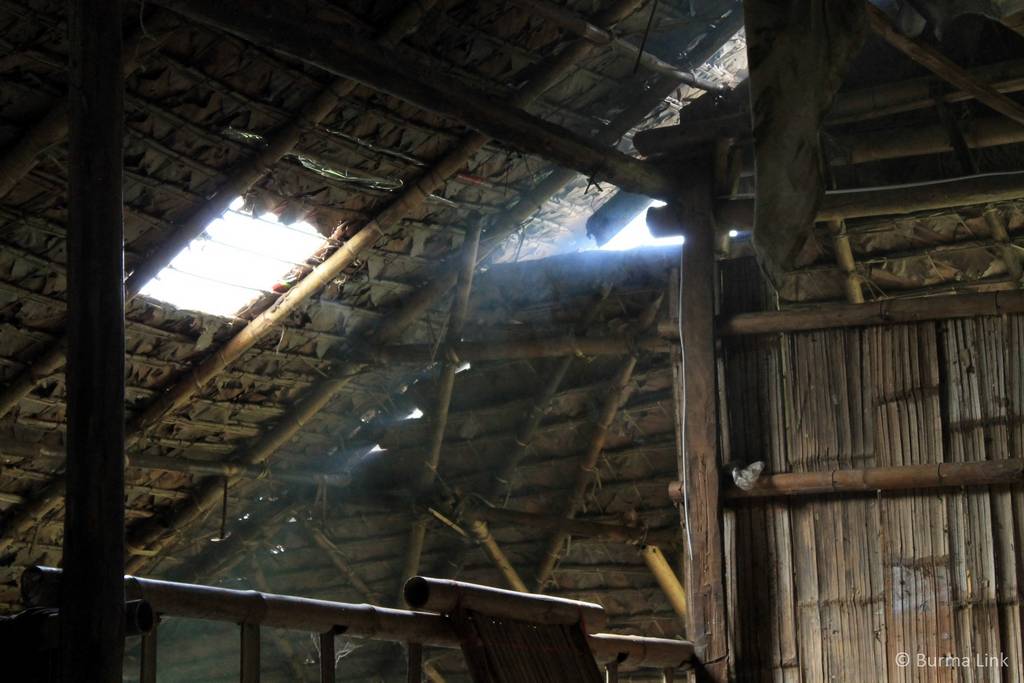
Camp residents live in bamboo houses as they are not allowed to use permanent building materials. (Photo: Liz Bordo)
International organisations such as the UNHCR, the United Nations Children’s Fund (UNICEF) and the International Committee of the Red Cross (ICRC) have also faced restrictions in Thailand that have made it difficult for them to provide even rudimentary protection for those who have crossed the border to Thailand (see Human Rights Watch, 2007). The framework of international principles that recognises the inherent dignity and the equal and inalienable rights of all members of the human family to be universally protected have little significance to refugees who live in Thailand.
The 1951 United Nations Convention lays down basic minimum standards for the treatment of refugees, including access to the courts, to primary education, and to work (UNHCR, 2010). The Convention defines a refugee as a person who:
“…owing to well-founded fear of being persecuted for reasons of race, religion, nationality, membership of a particular social group or political opinion, is outside the country of his nationality and is unable or, owing to such fear, is unwilling to avail himself of the protection of that country; or who, not having a nationality and being outside the country of his former habitual residence as a result of such events, is unable or, owing to such fear, is unwilling to return to it.”
Thailand is not a party to the 1951 Convention or its 1967 Protocol. For 30 years now, Thailand’s policy has been to confine the ‘persons of concern’ to their ‘temporary shelters’ until the situation in Burma would improve and the displaced could go home. The Burmese government has also consistently denied having any problems associated with refugees. In 2003, the government published a highly controversial statement:
“As Myanmar is not engaged in any war with other countries, there is no problem of refugees. The armed insurrection groups also have come back into the legal fold and there is peace in the country.” (Government of Burma, 2003, p. 54, IX A art.22 / 217)
While the UNHCR publically maintains that “…the generosity of the Royal Thai Government in hosting refugees and asylum-seekers has spanned several decades” (UNHCR, 2012b), others have described Thailand’s refugee policies as “fragmented, unpredictable, inadequate and ad hoc (e.g. Human Rights Watch, 2012e, p. 1).” Even UNHCR goes on to explain how they operate in a challenging environment, which is characterised by inadequate protection space for many persons of concern. Although UNHCR normally promotes three durable solutions for refugees; repatriation to their home countries, local integration in the host country, or resettlement to third countries, none of these solutions were available in Thailand until 2004 (TBC, 2012b), twenty years after the first refugees had arrived from Burma.
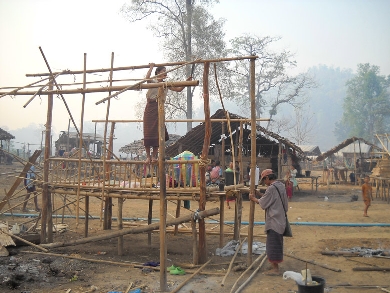
Refugees from Ler Per Her dismantling their huts in preparation for their departure from Mae U Su refugee site in Thailand. (Photo: KHRG)
Thai authorities allowed refugees to register with the UNHCR periodically during 2004 and 2005, and since 2005, all registered refugees have been eligible for resettlement to third countries. In June 2014, 96,206 had been resettled, vast majority (75%) of them to the US, followed by Australia, Canada, Finland, and Norway (TBC, 2014a). Departures for resettlement have declined each year since 2008, mainly because the majority of those who were able to register in 2004 and 2005 have already left. The group settlement program to the US has now closed, but a significant number remain in the pipeline and are expected to depart in 2015 (TBC, 2014a).
Of the current camp residents, 33.5% are not registered and thus ineligible for resettlement (TBC, 2015a). Refugees also have numerous concerns regarding resettlement that often lead to eligible refugees staying in the camps. One of the common issues is the inability to organise family reunions when resettled refugees have children that are over the age of 18. Those who have been resettled often have done so in order to provide for their families and relatives in the camps. Refugees typically maintain close links with the camps and frequently send money to their loved ones. According to Human Rights Watch (2012e), despite the UNHCR having a presence on the border since 1998, its role in the camps is extremely limited. Human Rights Watch adds: “The agency has demonstrated little ability to counter the Thai government’s ad hoc policies of containment and provides virtually no protection to Burmese asylum seekers outside the camps (p. 19).”
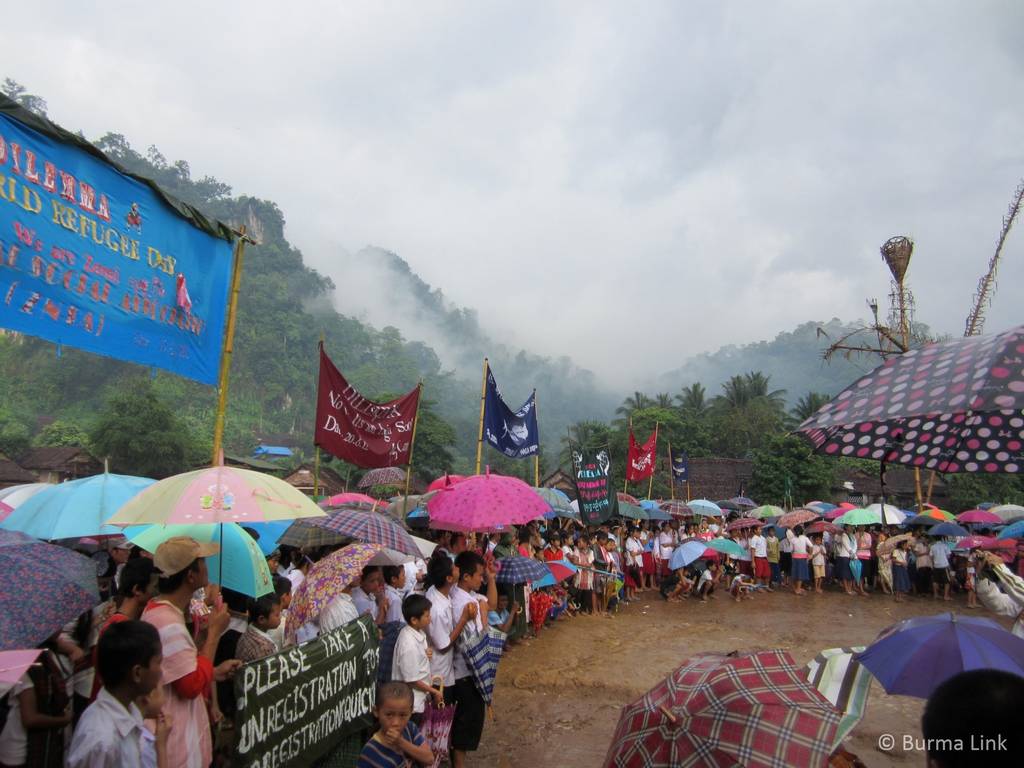
Refugees plead for UN registration on the World Refugee Day in June 2012, Mae La refugee camp. (Photo: Burma Link)
As a result of inadequate protection of refugees, as well as the highly restricted life in the camps, thousands live in the country as illegal aliens (for more information, see In Exile Outside the Camps). Many Burman nationals who have fled their home country, including most former (forcibly conscripted) child soldiers in the Burma army, also remain outside the refugee camps because they fear they may be ostracised by the refugee population who has fled Burmese military (most of whom are Burman) abuses and who are usually of a different ethnicity. Many Burman refugees in the camps talk about problems of discrimination, exclusion, and suspicions of being government spies, often leading them to depart the camps in the end. Other camp residents, who speak Burmese, have also faced similar problems as they have been mistaken for being Burman. Refugees belonging to minority groups, however, say that the situation has improved in recent years and refugees are mostly not afraid to speak Burmese anymore.
Due to the refugees in the camps being forced to be nearly completely dependent on outside help for food, shelter, protection and other basic needs, their coping mechanisms have been severely eroded. Travel and work restrictions have had adverse psychological and social effects on the refugees, decreasing their self-sufficiency, camp morale and mental health (TBC, 2012b).
“Living in the camp is similar to living in prison because I can’t go outside or make my own decision. I can commute only in the camp. The camp is surrounded by barbed wire. If we go outside of the camp, Thai police will arrest us. In the long run, it affects not only my physical but also my mental health.” (Christine, 22, Karen refugee, spoke with Burma Link in Mae La refugee camp in May 2014; see ‘Authorities Should Take Action for Refugees NOW’)
In a 2006 study, PU-AMI found that 50% of adult camp residents suffer from mental health problems and anti-depressants constituted one of the most common drug prescriptions for refugees (as cited in Human Rights Watch, 2012e, p. 19). Halting long-term sustainability prospects in the camps has also created a climate where refugees tend to think only short-term, from one ration to another. Some refugees have adapted this form of thinking already back in Burma where many were forced to flee Burma Army attacks from one hiding site to another. When the refugees will eventually return to Burma, many of them will need assistance not only in skills to sustain themselves but also in changing their thinking from short-term survival to long-term development. In a similar vein, those who have remained in hiding inside the country have been on the run for so long that many consider it normal to regularly flee and hide from government forces and to build a new village after another.
Considering the often traumatic backgrounds as well as the challenging circumstances that refugees face in Thailand, many people who visit the camps are impressed by the significant effort refugees make in order to maintain dignity and hope in the camp communities. Despite severe restrictions and depressive realities, refugees strive to remain active and to maintain their cultural traditions through practices such as teaching ethnic nationality languages and dances. People marry and have children, play sports, and organise festivals and other celebrations. Despite the devastating reality, life goes on. Thousands of people of Burma have come to consider these enclosed areas as their homes, trying to lead their lives as the best they can.
“From the beginning I was moved by the faith and dignity of the refugees I met, their determination to get on with their lives as best as they could, and their apparent belief that somehow, someday, justice would be done.” (Jack Dunford, Executive Director of TBC 1984-2012; TBC, 2013a)
While vast majority of refugees in the camps are ethnic Karen from eastern Burma, camps also vary greatly with regard to ethnic diversity. Umpiem Mai and Nu Po are the most ethnically diverse with over 20% of the camp populations comprising of non-Karen or Karenni ethnic groups. Mae Ra Ma Luang, Mae La Oon, and Tham Hin are the most homogenous with ethnic Karen comprising 99% of the populations (TBC, 2013c). Literacy rate in the camps is estimated as 60% (TBC, 2013c).
When living in the camps, one will notice the integral part that religion plays in most refugees’ lives. Religious buildings are centres of communal activities and refugees regularly attend religious ceremonies, sing and listen to religious songs, and read religious texts. Prayers are said before each meal, and often before the beginning of each school day. Most refugees are either Christian (51%) or Buddhist (36%), which is evident in the way refugees often ask visitors whether they are Christian or Buddhist, as if there are no other religions. In the Tak camps, however, there are also significant Muslim communities. Muslims have been particularly successful in setting up businesses in the camps, particularly noticeable in Mae La camp, where the main market has only one shop maintained by an ethnic Karen, the rest being run by Muslims.
Most of the camps are isolated in the mountains and at the end of dirt roads, while some camps, such as Mae La and Umpiem Mai, are located as close as 1 to 1.5 hour drive away from the nearest town of Mae Sot. The isolated camps tend to be far away from hospitals and some of them have no phone signal (Human Rights Watch, 2012e). The realities in the remote camps are very different from the easily accessible camps that also have much more opportunities for study and work. In these camps almost all residents are de facto refugees, as the camps have had very little pull factor other than safety from the Burmese military.
Three of the camps (Mae La, Tham Hin, and Ban Don Yang) are overcrowded (Human Rights Watch, 2012e). In all camps, the challenge of space is a significant concern. When living in one of the camps one will notice the almost complete lack of personal space or privacy. In some areas of the camps, houses are built right next to each other, people are everywhere, and it seems to never be quiet as there is always someone in the earshot singing, playing music, listening to the radio, or simply talking. Refugees who still have memories of life in Burma struggle to adapt to having no space around their houses; “Here, it is like fifty villages are crammed into one,” one refugee told TBC (2004, p. 53).
Due to space restrictions and limited housing supplies provided in the camps, many households comprise more than one family and young married couples typically continue to live with their parents. Space restrictions coupled with bamboo building materials also make camps into ‘fire traps’ and despite refugees being aware of the danger, fires regularly sweep through the communities. In February 2012, a huge fire in Umpiem camp destroyed as many as 1,000 houses (Karen News, February, 2012). In April 2013, 36 refugees died in a tragic fire that destroyed Ban Mae Surin refugee camp in Mae Hong Son Province. In December 2013, around 750 refugees were left homeless in Mae La camp when more than a hundred houses were destroyed by a fire. The next day one refugee woman died in a fire in Ban Mai Nai Soi camp.
Although some basic health care is provided in the camps, diseases such as malaria, dengue fever and tuberculosis are still common among the refugees. According to TBC (2015a), the border-wide average chronic (stunting) malnutrition rate is classified as “very high”, with camps with the highest stunting rates being located in the most remote areas of the border.
The camps are highly organised with regularly elected camp leaders, committees, and section leaders, although refugees regularly complain about corruption and lack of transparency in the leadership. The Karen Refugee Committee (KRC) and the Karenni Refugee Committee (KnRC) are the overall representatives of the refugees living in the camps. These Committees coordinate and oversee all camp activities through the Camp Committees, coordinate assistance provided by NGOs, and liaise with UNHCR, Thai authorities, and security personnel (TBC, 2013a). Each camp is headed by a single leader and hundreds of people serve on the Camp Committees, organising the storage and distribution of rations, safeguarding the camps’ physical environment and infrastructure, and overseeing health clinics, the school system, and the administration of justice (TBC, 2004).
The latest Refugee Committee and Camp Committee elections were held in early 2013. According to TBC (2013a), all registered and unregistered refugees over the age of 20, regardless of gender, religion and ethnicity, were able to vote. Camp residents, however, voiced concerns over the elections. According to one young refugee who spoke with Burma Link, “Most people don’t know whether they are eligible to vote or not. So, most unregistered didn’t vote”.
A variety of CBOs formed by members of the refugee communities also support specific social groups, such as the Karenni Students Union, the Karen Youth Organisation, and the Karen Handicapped Welfare Association. Refugee women’s organisations have also actively sought ways to improve women’s participation in all aspects of society.
TBC remains the only agency responsible for providing food and shelter assistance to the refugees in the camps. In the past, TBC also regularly purchased and distributed blankets, mosquito nets, clothing for children under five and thread for longyi weaving, sleeping mats, and cooking pots both to current and newly arrived camp residents. Recent funding cuts on the border have forced TBC to cease the provision of all non-food items even to new arrivals. Only cooking stoves and donated items are still being distributed to refugees. As a consequence of the funding cuts, TBC’s food rations have also fallen substantially below minimum daily nutritional levels (see TBC, 2013a, p. 44). Health and education services for the refugees have also been cut back, having an adverse effect on the camp residents.
As the recent restrictions in movement have strictly prohibited refugees from leaving camp premises, the reduced rations have become a grave concern. According to the refugees themselves, it is the poorest and the most vulnerable who suffer the consequences as they are not able to go to the forest to hunt for rats and collect vegetables, nor to buy extra food as they are now not allowed to take on work as daily workers. Some refugees are now employing more risky behaviours and strategies in order to bridge the widened gap between their basic needs and the humanitarian assistance they receive. While some households are able to supplement their needs through well-established economic activities, others are simply no longer able to meet their basic needs.
In order to cope with the situation, TBC has employed a method of identifying food secure and insecure households in order to implement Community Managed Targeting, in which self-reliant refugees will forfeit their rations whilst the most vulnerable receive extra supplies (see TBC, 2013a, p. 45). Eye-witness accounts, however, tell a grim story as Burma Link has received reports of some refugees believing they are being starved out in order to avoid their continuing assistance and future repatriation.
Many refugees refuse to settle for their faith as helpless and passive victims and are making great efforts to cope and provide for their families through taking part in different livelihood activities, when possible. Some international NGOs and local CBOs such as TBC provide the refugees with opportunities for skills training and income generation, although these projects reach only a small part of refugee populations. Refugees are also often left frustrated as after taking part in the training, they have nowhere to use their newly-found skills. Some have taken part in one TBC training after another, unable to apply their skills in practice.
TBC does, however, have several successful projects in the camps such as the Community Agriculture Program (CAP) that is currently implemented in eight camps (TBC, 2014a). CAP gardening activities are important in that they increase the availability of fresh food in camps, and prepare refugees with vital livelihood skills. As a result of CAP activities, hundreds of households in the camps are now able to cultivate their own gardens. TBC also supports some projects run by local CBOs on Burma side of the border, e.g. the Back Pack Health Worker Team’s (BPHWT) water supply and sanitation projects and the Karen Human Rights Group’s (KHRG’s) village agency project.
Other organisations also undertake training activities in the camps. COERR, for example, has trained refugees on appropriate and sustainable organic agricultural practices, assisted refugee communities to develop basic social work technical skills, and provided vocational training for individuals in extremely vulnerable situations (see COERR – Project).
These activities, when successfully implemented, are essential for the refugees to regain confidence, motivation, and a sense of independence from external aid. They will also be extremely valuable for refugees if they return to Burma or are resettled in third countries. Since 2005, the UNHCR and CCSDPT have advocated with the Thai authorities for a relaxation in the policy of confinement to camps (see TBC, 2013a). The policy nevertheless remains in place and restrictions have recently been tightened. While many refugees make significant efforts to remain active in the challenging and often depressive situation, the vast majority of camp residents are increasingly reliant on outside support and aid as a result of forced passivity.
The recent political changes and ceasefire talks in Burma have resulted in widespread and grossly premature talks of repatriating the refugees. Only one month after Burma transitioned to a nominally civilian government in March 2011, Thai authorities announced that they are in the process of discussion with the Burmese government about closing the refugee camps (Chitradon, April, 2011). More recently, the Thai junta announced that it wants to repatriate all refugees by 2015 (Saw Yan Naing, July, 2014b). These are grave concerns for the refugees as major obstacles for safe repatriation remain. In fact, none of the reasons why refugees fled have seen a sustainable solution; peace process has stalled, ceasefires remain fragile and unpredictable, landmines contamination is among the worst in the world, health and education is lacking, poverty is rampant, and human rights violations continue (see e.g. Davis, Gittleman, Sollom, Richards, & Beyrer, 2012; KHRG, 2014a; ND-Burma, 2013b, 2014a, 2014b).
Although the consensus is that conditions are not yet conducive for refugees to return, there are now significant concerns that camps could be closed and refugees repatriated before they can do so with a sense of dignity and hope. In recent years, even TBC has changed their focus to preparedness for refugee and IDP return (TBC, 2013a, 2014a). Talks about repatriation coupled with reduced aid and increased restrictions have caused anxiety and uncertainty among the refugees who do not feel safe returning to their homeland. Despite the positive change that has emerged during the past years, much more needs to be done before refugees can safely return to Burma yet no one knows when the refugees will have to go back and whether they can do so voluntarily. Read more about Repatriation of Refugees.
It is hoped that organisations such as the TBC and UNHCR, as well as the international donor community, will be willing to continue necessary support on the border until the time is right for refugees to return. A major current challenge, however, is that many NGOs and CBOs along the border are struggling to sustain even basic services to refugees as donors are shifting their funds inside Burma. One can only hope that agencies such as the UNHCR will respect its public commitments and “ensure that repatriation is voluntary, undertaken in safety and dignity, and takes place only when conditions are conducive” (UNHCR, 2013b).
Updated April 27, 2015
RECOMMENDED READING
On April 27, 2015, Burma Link and Burma Partnership launched a joint briefing paper, Voices of Refugees – Situation of Burma’s Refugees Along the Thailand-Burma Border (click to download PDF).
Continue to In Exile Outside the Camps
